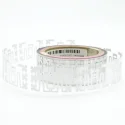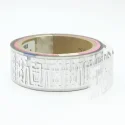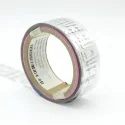Ucode 7 rfid uhf inlay labels tag
RFID Dry Inlays are described as "Dry" due to their lack of adhesive backing. Dry inlays attach an RFID microchip (IC) and antenna to a material or substrate called a web. These inlays look like they have been laminated and come standard with no adhesive
RFID Dry Inlays are described as "Dry" due to their lack of adhesive backing. Dry inlays attach an RFID microchip (IC) and antenna to a material or substrate called a web. These inlays look like they have been laminated and come standard with no adhesive.

Labels with self-adhesive functions, which can be peeled off on boxes, bottles, and other items by a labeling machine on the production line, or manually pasted on car windows (such as taxis), documents (such as university student ID cards) It can also be made into a hangtag to hang on the item, and use the label compounding equipment to complete the processing process. The product structure consists of a surface layer, chip circuit (INLAY) layer, adhesive layer, and bottom layer. The surface layer can be made of paper, PP, PET as the covering material (printed or not) and other materials as the surface of the product; the chip circuit (INLAY) has various sizes, various chips, and various EEPROM capacities, which can be customized according to user needs. After configuration, it is positioned on the adhesive surface; the adhesive layer is completed by double-sided adhesive or gluing; the finished product can be rolled or sheet.

| LF 125KHZ CHIP(portion) | |||
| Chip Name | Protocol | Capacity | Frequency |
| TK4100 | ISO 11784/11785 | 64 bits | 125 kHz |
| EM4200 | ISO 11784/11785 | 128 bits | 125 kHz |
| EM4205 | ISO 11784/11785 | 512bit | 125 kHz |
| EM4305 | ISO 11784/11785 | 512 bits | 125 kHz |
| EM4450 | ISO 11784/11785 | 1K | 125 kHz |
| T5577 | ISO 11784/11785 | 330 bits | 125 kHz |
| ATA5577 | ISO 11784/11785 | 363bit | 125 kHz |
| HITAG 1 | ISO 11784/11785 | - | 125 kHz |
| HITAG 2 | ISO 11784/11785 | - | 125 kHz |
| HITAG S256 | ISO 11784/11785 | - | 125 kHz |
| HITAG S2048 | ISO 11784/11785 | - | 125 kHz |
| HF 13.56 MHz Chips(portion) | |||
| Chip Name | Protocol | Capacity | Frequency |
| Ntag213 | ISO14443A | 180 byte | 13.56 MHz |
| Ntag215 | ISO14443A | 540 byte | 13.56 MHz |
| Ntag216 | ISO14443A | 924 byte | 13.56 MHz |
| MIFARE Classic 1K | ISO14443A | 1 KB | 13.56 MHz |
| MIFARE Classic 4K | ISO14443A | 4 KB | 13.56 MHz |
| MIFARE Ultralight EV1 | ISO14443A | 80 byte | 13.56 MHz |
| MIFARE Ultralight C | ISO14443A | 192 byte | 13.56 MHz |
| MIFARE Classic S50 | ISO14443A | 1K | 13.56 MHz |
| MIFARE Classic S70 | ISO14443A | 4K | 13.56 MHz |
| MIFARE DESFire | ISO14444A | -- | 13.56MHz |
| ICODE SLIX | ISO15693 | 1024 bits | 13.56 MHz |
| ICODE SLI | ISO15693 | 1024bits | 13.56 MHz |
| ICODE SLI-L | ISO15693 | 512bits | 13.56 MHz |
| ICODE SLI-S | ISO15693 | 512bits | 13.56 MHz |
| NTAG203 | ISO18082 | - | 13.56 MHz |
| NTAG213 | ISO18082 | - | 13.56 MHz |
| NTAG215 | ISO18082 | 924 byte | 13.56MHz |
| NTAG216 | ISO18082 | 180 or 924 bytes | 13.56 MHz |
| Topaz512 | ISO18082 | 13.56 MHz | |
| 860-960MHz Chips(portion) | |||
| Chip Name | Protocol | Capacity | Frequency |
| Alien H3(Higgs 3) | ISO18000-6C | 512 bits | 860~960 MHz |
| Alien H490 (Higgs 4) | ISO18000-6C | 513 bits | 860~960 MHz |
| Impinj Monza 4 | ISO18000-6C | 96 bits | 860~960 MHz |
| Ucode 7 | ISO18000-6C | 128bits | 860~960 MHz |
| Ucode 8 | ISO18000-6C | EPC 128bits | 860~960 MHz |
| UCODE G2iL | ISO18000-6C | 128 bits | 860~960 MHz |
| M4QT | ISO18000-6C | 512bits | 860~960 MHz |
| Monza R6 | ISO18000-6C | 96bits | 860~960 MHz |
| Monza R6-P | ISO18000-6C | 32bits | 860~960 MHz |
| EM4124 | ISO18000-6C | 96bits | 860~960 MHz |
| EM4126 | ISO18000-6C | 208bit | 860~960 MHz |
| EM4325 | ISO18000-6C | - | 860~960 MHz |
| ME4423 | ISO18000-6C | 64bits | 860~960 MHz |





